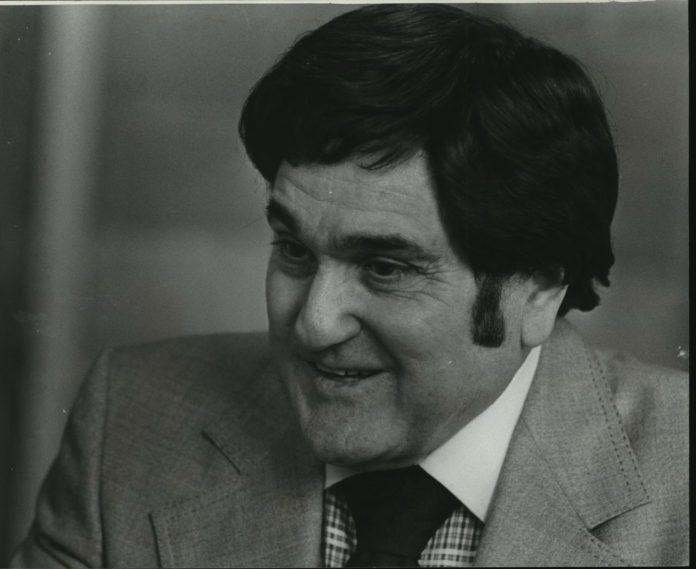
AKRON, Ohio — The Rev. Ernest W. Angley, a faith-healing Pentecostal televangelist who claimed a lifetime of personal visits from God, has died at age 99, according to an announcement Friday on the website of his Cuyahoga Falls-based ministry.
The preacher rose over the decades from tent revivalist to running a world-wide ministry with his namesake from what would be a vast home base in suburban Akron. Delivering his sermons in his distinctive drawl, Angley was one of the most influential modern-day faith healers and televangelists, though not as flashy as some of his contemporaries.
With that stature came controversy, though, with scandals and lawsuits about his claimed abilities and business practices that plagued him and his Ernest Angley Ministries until near the end of his life.
“Pastor, evangelist and author Rev. Ernest Angley has gone to Heaven to be with his Lord and Master at 99,” a message posted Friday on the Ernest Angley Ministries website read. “He touched multitudes of souls worldwide with the pure Word of God confirmed with signs, wonders, miracles and healings. He truly pleased God in all things.”
The ministry did not release a cause of death.
Angley, whose father worked in a textile mill, was born in 1921, the middle of seven children reared from humble roots in Gastonia, North Carolina. He left the Baptist Church at age 18 to become a Pentecostal and worked as a traveling preacher during the Depression.
At 20, Angley attended the Church of God Bible Training School in Tennessee, where he met his wife, Esther Lee – known as “Angel.” They decided not to have children because he wanted Angel on the road with him, The Washington Post reported in a 1980 profile.
Angley claimed that at 23, he suffered from an ulcerated stomach that couldn’t be cured until the Lord visited again and healed him.
The Angleys appeared together in tent revivals, auditoriums and churches throughout the south before moving the ministry – on God’s advice – to Springfield Township, southeast of Akron, in 1954. Within three years, the church had matured from a parking-lot tent to a $1 million building that drew 3,000 followers a week.
He became was among the most influential modern-day faith healers, ranked with the likes of Oral Roberts, William Branham and Aimee Semple McPherson, said Stephen Pullum, a communications studies professor at the University of North Carolina-Wilmington and author of “Foul Demons, Come Out!: The Rhetoric of Twentieth-Century American Faith Healers.”
“Angley offered hope to the hopeless,” he said.
The preacher said he was a restless 7-year-old, lying in bed unable to fall asleep, when the Lord first paid him a visit.
His room started spinning as he was lifted into space, floating among the night stars, bed and all.
It was a scene the peculiar southern preacher often delivered in his sermons, complete with his unmistakable sing-songy southern drawl and brown toupee atop a squat, neckless body inspired characters for comedian Robin Williams and others.
Angel, who served as choir director, organist, bookkeeper and church counselor, died in 1970 of colitis at age 49 at St. Vincent Charity Hospital in Cleveland. About 4,000 mourners attended her elaborate funeral. One of the wreaths by her silver-plated casket featured a phone off the hook and a banner that read, “Jesus Called.”
When Angley, who had put his healing hands on so many, was asked why he couldn’t heal his wife, he told The Washington Post, “There comes a time for God to take a person. Just because I have the power to heal doesn’t mean I am going to override the Scriptures.”
Angley, in fact, didn’t consider himself a faith-healer, and believed in the power of medical science. He once told the Akron Beacon Journal that God gave man knowledge and wisdom to care for the sick, but that “when man has done all he can do, there is still God to help us.”
Over the subsequent decades, Ernest Angley Ministries continued to grow through a series of moves and property acquisitions.
Among the ministry’s holdings: the domed 5,400-seat Grace Cathedral, with imported chandeliers, 32-ton indoor cross and an organ covered in 24-karet gold leaf; the 1,000-seat Cathedral Buffet restaurant and banquet center; a bible college; and a private 747 used to jet overseas for services he conducted in more than 30 countries.
By 2005, Grace Cathedral, which Angley founded in 1957, had 7,000 to 8,000 members, the church’s then-business manager Ray Spangler, the church’s business manager said in 2005. However, The Beacon Journal has said attendance has dwindled in recent years.
Early on, Angley aired services on radio – until God told him to take his message to television. So Angley bought a TV station, WBNX-55, which has been on the air since 1985.
Bob Abelman, a Cleveland State University communications professor emeritus and expert in religious broadcasting, described Angley’s program – and Angley – as “very old-school. He embraced many of the Elmer Gantry stereotypes.”
Angley’s program wasn’t glitzy, like the productions of other popular televangelists, he said. His suits were old. His look was old. The program was taped in front of a small audience. The music was traditional and the songs lip-synced.
“It was a lot like what 1950s, early 1960s television was like,” which was also part of the program’s charm for devoted viewers, Abelman said.
But the climax of Angley’s services were dramatic weekly “miracle” sessions. The sick, frail and disabled, desperate to see, hear, speak, walk or live disease-free, lined up by the hundreds to have his hands laid on them.
“Come OUT!” Angley would shout, exorcising demons by quickly removing his fingers from a believer’s ears as if uncorking blockages.
“Say bay-bee,” he would instruct the worshipper who could suddenly hear and repeat the words. As Angley placed his hands on their faces, parishioners would fall back, weak-kneed, into the arms of church ushers.
When Pullum first stumbled across Angley on cable TV, he said he wasn’t sure “if it was a comedy act or someone seriously preaching.”
Angley seemed to take the jabs in stride.
“Elijah was a baldheaded man,” he once said when asked why he couldn’t heal his own scalp. “God didn’t promise to bring us into perfection in this life. It’s in the next life.”
Unlike many high-profile televangelists, such as Jimmy Swaggert, Jim Bakker and Jerry Falwell, Angley wasn’t tainted by financial scandals in the 1980s. But, by the nature of his work, Angley was controversial, and his ministry was mired in scandals and legal battles.
A 65-year-old heart patient died at one of his services in North Carolina. A 15-year-old girl was stabbed to death by a fellow church member as she volunteered at Cathedral Buffet, and Angley later settled a lawsuit filed by the teenager’s father that said the preacher still allowed the killer access to her after he was made aware of unwelcome advances.
And the ministry settled a lawsuit by a 64-year-old Cleveland woman who said she was assaulted by security guards during a healing service.
The most notable incident was in 1984. Angley was arrested in Munich, Germany, for practicing healing without a license. He made bond and was released, but the city was hit with its worst hailstorm in history the next day.
Angley later wrote in one of his many books that the storm was God’s payback.
Controversies and legal problems persisted well into his 80s and 90s.
Health officials in Guyana criticized him for a series of advertisements that suggested people could be cured of AIDS if they attended his services in that country.
In 2014, the Beacon Journal ran a series of stories where former members claimed that that Angley’s church operated like a cult, where women were pressured to get abortions and men were persuaded to have vasectomies.
The former members also said Angley, a longtime public opponent of homosexuality, was himself gay and personally examined the genitals of male church members before and after surgeries. They also said he looked the other way when other members of his church committed sexual abuse, according to the Beacon-Journal.
Angley said the former church members were lying.
The U.S. Labor Department filed suit in 2015 against the Angley and his Cathedral Buffet following an investigation spurred by the Beacon Journal series. The lawsuit said Angley and the buffet violated the Fair Labor Standards Act by its use of members of his flock as unpaid workers at a for-profit restaurant and did not document the volunteers’ work.
A federal judge in March 2017 ordered Angley and the buffet to pay more than $388,000, half of which was back wages, the other half in damages. The judge, Benita Pearson, wrote that that trial testimony showed that the preacher and the restaurant’s managers encouraged members of his church to work at the buffet without pay.
The Labor Department also cited Angley in 1999 for the same thing. The buffet paid $37,000 in back wages at the time and agreed to comply with labor laws going forward.
The buffet, which Angley said never made a profit, closed its doors the following month. In April 2018, the 6th U.S. Circuit Court of Appeals overturned Pearson’s decision, ruling that members of his church who worked at the buffet had no expectation of being paid.
Angley was also sued in 2018 by former Associate Pastor Brock Miller, who accused the preacher of sexually assaulting and harassing him over a decade. The suit said Angley forced Miller “to undergo a vasectomy – to ensure that he was never able to have children,” as a condition of his employment.
The preacher countersued later that year. The case settled for an undisclosed amount in February 2020.
As large as his following grew and as many assets as the ministry acquired, Angley lived for years in a three-bedroom brick ranch-style house in Springfield Township. The bouncy, animated preacher whose services lasted for several hours maintained a diligent pace well into later years, scoffing at the notion of ever slowing.
“I don’t plan to retire until I get to heaven,” he told the Beacon Journal in 1999, “and the Lord is building me a mansion up there.”







